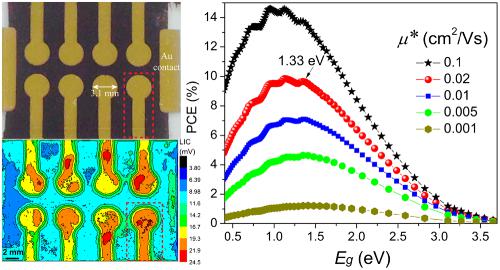当前位置:
X-MOL 学术
›
Prog. Photovoltaics
›
论文详情
Our official English website, www.x-mol.net, welcomes your feedback! (Note: you will need to create a separate account there.)
Colloidal quantum dot solar cell power conversion efficiency optimization using analysis of current‐voltage characteristics and electrode contact imaging by lock‐in carrierography
Progress in Photovoltaics ( IF 6.7 ) Pub Date : 2017-08-10 , DOI: 10.1002/pip.2920 Lilei Hu 1 , Mengxia Liu 2 , Andreas Mandelis 1, 2 , Alexander Melnikov 1 , Edward H. Sargent 2
Progress in Photovoltaics ( IF 6.7 ) Pub Date : 2017-08-10 , DOI: 10.1002/pip.2920 Lilei Hu 1 , Mengxia Liu 2 , Andreas Mandelis 1, 2 , Alexander Melnikov 1 , Edward H. Sargent 2
Affiliation

|
Although the power conversion efficiency (PCE) of colloidal quantum dot solar cells (CQDSCs) has increased sharply, researchers are struggling with the lack of comprehensive device efficiency optimization strategies, which retards significant progress in CQDSC improvement. This paper addresses this critical issue through analyzing the impact of colloidal quantum dot (CQD) carrier hopping mobility, bandgap energy, illumination intensity, and electrode/CQD interface on device performance to develop a guiding criterion for CQDSC PCE optimization. This general strategy has been used for the successful fabrication of high‐efficiency CQDSCs yielding certified PCEs as high as 11.28 %. A major experimental finding of this work is that the widely used constant photocurrent density (Jph) assumption is invalid as Jph is external‐voltage dependent due to the low carrier hopping mobility. Furthermore, the theoretical model developed herein predicts the nonmonotonic dependence of CQDSC PCE on carrier hopping mobility and bandgap energy, which were also demonstrated with the high‐efficiency CQDSCs. These results constitute a revision basis of the widespread belief that higher mobility and lower bandgap energy correspond to a higher CQDSC efficiency. Furthermore, electrode/CQD interface‐dependent surface recombination velocities were investigated in the framework of our abovementioned theoretical model using lock‐in carrierography, a contactless, large‐area frequency‐domain photocarrier diffusion‐wave imaging methodology that elucidated the carrier collection process at the electrodes through open‐circuit voltage distribution imaging. Lock‐in carrierography eliminates the limitations of today's widely used small‐spot (<0.1 cm2) testing methods which, however, raise questionable overall solar cell performance and stability estimations.
中文翻译:

胶体量子点太阳能电池的功率转换效率优化,采用电流-电压特性分析和通过锁定载波照相技术进行的电极接触成像
尽管胶体量子点太阳能电池(CQDSC)的功率转换效率(PCE)急剧增加,但研究人员仍在努力克服缺乏全面的器件效率优化策略的问题,这阻碍了CQDSC改进的重大进展。本文通过分析胶体量子点(CQD)载流子跳变迁移率,带隙能量,照明强度和电极/ CQD接口对器件性能的影响,为CQDSC PCE优化提供指导标准,从而解决了这一关键问题。此通用策略已用于成功制造高效CQDSC,从而使认证的PCE高达11.28%。这项工作的主要实验发现是,广泛使用的恒定光电流密度(J ph)假设无效,因为J ph由于载流子跳变率低,因此取决于外部电压。此外,本文开发的理论模型预测了CQDSC PCE对载波跳跃迁移率和带隙能量的非单调依赖性,这也由高效CQDSC证明。这些结果构成了以下普遍观点的修正基础:更高的迁移率和更低的带隙能量对应于更高的CQDSC效率。此外,在上述理论模型的框架内,我们使用锁定载流子照相法研究了电极/ CQD界面相关的表面重组速度,该技术是一种无接触的大面积频域光载流子扩散波成像方法,阐明了载流子收集过程。电极通过开路电压分布成像。2)然而,测试方法却引起了可疑的整体太阳能电池性能和稳定性评估。
更新日期:2017-08-10
中文翻译:

胶体量子点太阳能电池的功率转换效率优化,采用电流-电压特性分析和通过锁定载波照相技术进行的电极接触成像
尽管胶体量子点太阳能电池(CQDSC)的功率转换效率(PCE)急剧增加,但研究人员仍在努力克服缺乏全面的器件效率优化策略的问题,这阻碍了CQDSC改进的重大进展。本文通过分析胶体量子点(CQD)载流子跳变迁移率,带隙能量,照明强度和电极/ CQD接口对器件性能的影响,为CQDSC PCE优化提供指导标准,从而解决了这一关键问题。此通用策略已用于成功制造高效CQDSC,从而使认证的PCE高达11.28%。这项工作的主要实验发现是,广泛使用的恒定光电流密度(J ph)假设无效,因为J ph由于载流子跳变率低,因此取决于外部电压。此外,本文开发的理论模型预测了CQDSC PCE对载波跳跃迁移率和带隙能量的非单调依赖性,这也由高效CQDSC证明。这些结果构成了以下普遍观点的修正基础:更高的迁移率和更低的带隙能量对应于更高的CQDSC效率。此外,在上述理论模型的框架内,我们使用锁定载流子照相法研究了电极/ CQD界面相关的表面重组速度,该技术是一种无接触的大面积频域光载流子扩散波成像方法,阐明了载流子收集过程。电极通过开路电压分布成像。2)然而,测试方法却引起了可疑的整体太阳能电池性能和稳定性评估。



























 京公网安备 11010802027423号
京公网安备 11010802027423号